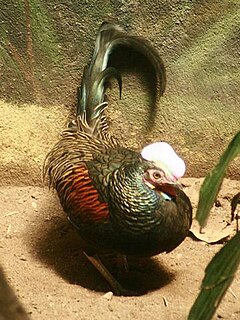Green junglefowl: Difference between revisions
BOT--Reverting link addition(s) by 75.85.180.16 to revision 371898346 (http://tommyspetparadise.webs.com/) |
|||
| Line 33: | Line 33: | ||
* [http://www.birdlife.org/datazone/species/index.html?action=SpcHTMDetails.asp&sid=228&m=0 BirdLife Species Factsheet] |
* [http://www.birdlife.org/datazone/species/index.html?action=SpcHTMDetails.asp&sid=228&m=0 BirdLife Species Factsheet] |
||
* [http://www.redlist.org/search/details.php?species=47073 IUCN Red List] |
* [http://www.redlist.org/search/details.php?species=47073 IUCN Red List] |
||
* [http://tommyspetparadise.webs.com/ Green Junglefowl Breeding] |
|||
* [http://www.gbwf.org/pheasants/junglefowl_green.html Green Junglefowl information and picture] |
* [http://www.gbwf.org/pheasants/junglefowl_green.html Green Junglefowl information and picture] |
||
* [http://www.feathersite.com/Poultry/NDG/BRKGreenJF.html Information about the Green Junglefowl] |
* [http://www.feathersite.com/Poultry/NDG/BRKGreenJF.html Information about the Green Junglefowl] |
||
Revision as of 01:40, 24 July 2010
| Green Junglefowl | |
|---|---|

| |
| Scientific classification | |
| Kingdom: | |
| Phylum: | |
| Class: | |
| Order: | |
| Family: | |
| Genus: | |
| Species: | G. varius
|
| Binomial name | |
| Gallus varius Shaw, 1798
| |
The Green Junglefowl, Gallus varius also known as Javan Junglefowl, Forktail or Green Javanese Junglefowl is a medium-sized, up to 75 cm long, bird in the pheasant family Phasianidae. Recent molecular work (Kimball et al., Barrowclough) has revealed that Junglefowl and Pheasants are not monophyletic. The Green Junglefowl is endemic to Java, Bali, Lombok, Komodo, Flores, Rinca and small islands linking Java with Flores, Indonesia. It has been introduced to the Cocos (Keeling) Islands where there is a small wild population.
The coloration of the Green Junglefowl is sexually dichromatic. The male's plumage is dark and blackish at a distance. A closer view will reveal an iridescent mantle of gleaming scales reminiscent in colour and pattern to those seen in the Ocellated Turkey and Green Peafowl. Each scale is vivid blue at its base and moves through various shades of gold and bronzed green. Specialized plumes framing the throat of the male Green Junglefowl are highly light reflective and appear violet at the proximal and sky blue at the distal edges. The lesser coverts of the wing are a striking burned orange with bronzed black centers. The distal edges of the greater secondary coverts are vivid ocher. Like its distant cousin the Red Junglefowl, the breast and ventral regions are a dense light absorbing black. Like its closer relative the Ceylon Junglefowl, the male Green Junglefowl exhibits vivid 'windows' of bare facial skin that contrasts against the dark scarlet red of the face. The Green Junglefowl exhibits an ice blue center in its comb. A region of electric yellow facial skin extends extends below each ear, delineating the plumed hackles from gular lappet. Its head is topped by a light blue comb, which turns purple or red towards the top. Its wattle is also of the same colour but is bordered with blue on the edges and yellow closer to the throat. The female is mostly brown with occasional green feathers and has no comb.

The Green Junglefowl is being maintained and increasingly bred in captivity as its genetic diversity is disappearing. This is because these birds are bred with domestic chickens by many people, producing a hybrid known as the Bekisar. The Bekisar has become very popular in the East Java province and has become the mascot-bird of the area. Therefore the Green Junglefowl requires more protected conditions than chickens. However, it is known to be able to fly more strongly than chickens, and has been seen flying from island to island in its native range, where it lives and breeds along coastal areas.
The Green Junglefowl usually lives in groups of two to five in the wild and led by a dominant male, who takes the flock to feed and drink and then back into the cover of the forest. In the night the flock roosts in bamboo stands at 15–20 feet above the forest floor. In the breeding season the dominant males in each flock are challenged by other males without flocks. The two males would clap their wings and crow loudly while fighting each other with their spurs.
The captive Green Junglefowl requires warm aviaries with lots of foliage and cover due to their shy nature and are fed with grains and seeds, as well as fruit and insects as these are the same type of food they would feed on in the wild. This bird has also been known for a long time as a pet animal because of its beauty and unique call.
The Green Junglefowl is evaluated as Least Concern on the IUCN Red List of Threatened Species.
References
- Template:IUCN2006 Database entry includes justification for why this species is of least concern

